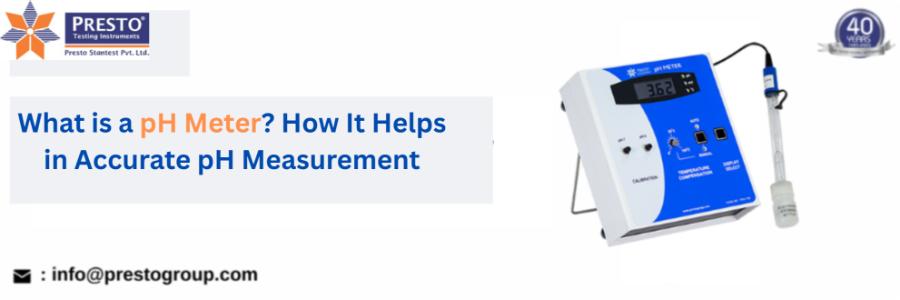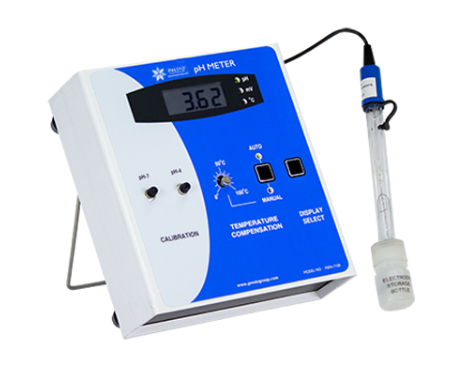

A pH meter is a very useful tool in science. It tells us if something is acidic or alkaline. Scientists use it in experiments, farmers use it to check soil, and food makers use it to make recipes better. In this guide, we will talk about how it works, its uses, parts, and even the cost. Let’s learn more about pH meters.
A pH meter is a tool that measures how acidic or basic a solution is. It works by detecting the activity of hydrogen ions and shows the result on a pH scale. Unlike litmus paper, which only gives a rough idea, a pH meter gives precise readings. This makes it essential in labs, industries, and even out in the field. By turning tiny electrical signals into clear measurements, it has changed the way we study chemicals.

pH stands for “Potential of Hydrogen” or “Power of Hydrogen,” reflecting the measure of hydrogen ion activity in a solution. A pH meter simply denotes an instrument designed to measure this potential—a clear, purpose-driven name rooted in basic chemistry.
The pH meter isn’t just a lab toy—it is a workhorse in many areas of life. Here are some of its top uses:→
In short, wherever liquids are involved, a pH meter can play a starring role. It’s a small tool with a big impact!
Picture this:→ a sleek probe dips into a beaker of liquid. The glass electrode, a thin walled bulb, protrudes at the tip, encased in a protective–sleeve alongside the reference electrode. both connect via wires to a compact meter, its screen glowing with a pH value say, 5.3 for orange juice.
.png)
A temperature probe might peek out, linked to the meter for automatic adjustments. The diagram is simple yet elegant: probe meets solution, electrodes sense ions, meter translates voltage. This visual clarity demystifies the tool, showing how form follows function in pH measurement.
The pH meter works on a principle called potentiometry. It measures the tiny voltage difference between a glass electrode and a reference electrode, which depends on how many hydronium ions (H+) are in the solution. The glass electrode has a special membrane that reacts with these ions, creating a voltage. The reference electrode don’t react, giving a stable baseline.
This voltage difference is about 59 millivolts per pH unit at room temperature and follows the Nernst equation, which links voltage to ion concentration. The pH meter amplifies this small signal and converts it into a pH reading using calibration solutions, usually pH 4 and 7. In simple terms, it’s a tiny electrical measurement that tell us how acidic or basic a solution is.
The pH scale (0-14) shows how angry or alkaline a solution is. The pH is 7 neutral (water), is acidic (lemon juice) below 7 and is alkaline above 7 (eg hindque). This is logarithmic, so each step means a ten times change in acidity/alkalinity, which is necessary in science and industry.
A pH meter is a device designed to measure the hydrogen ion concentration in a solution. Its main components includes:
These components works together to deliver precise pH readings, making pH meters indispensible in labs.
pH meters varies in design and functionality, each suited for specific tasks. Below is a table summarize the main types:
| Type | Description | Best Use | Advantages | Limitations |
| Benchtop pH Mete | Stationary, high-precision device with advance features like data logging. | Laboratory experiments | High accuracy, multiple calibration points | Not portable, high cost |
| Portable pH Meter | Compact, battery-operated device for field measurement. | Fieldwork (e.g., soil, water testing) | Portable, durable | Less precise then benchtop models |
| Pen-Type pH Meter | Small, affordable, and simple device for quick reading. | Basic testing, educational use | Easy to use, low cost | Limited accuracy, fewer feature |
| Inline pH Meter | Integrated into systems for continous pH monitoring. | Industrial processes (e.g., water treatment) | Real-time monitoring | Expensive, complex instalation |
Choosing the right pH meter depend on your specific needs, budget, and required precision.
Using a pH meter correct ensures reliable results. Below is a table outline the steps:
| Step | Description | Tips |
| Prepare Equipment | Ensure the meter and electrode is clean; gather buffer solutions (pH 4, 7, 10). | Check electrode storage solution (3M KCl). |
| Calibrate the Meter | Rinse electrode, immerse in pH 7 buffer, adjust to 7.0; repeat with pH 4 and 10. | Use fresh buffers for accurateness. |
| Prepare the Sample | Place sample in a clean container; stir gentle if needed. | Avoid contamination from prior sample. |
| Measure the pH | Rinse electrode, immerse in sample, wait 30–60 second for stable reading. | Ensure electrode is fully submurged. |
| Record the Result | Note the display pH value. | Double-check for stablity. |
| Clean and Store | Rinse electrode with distiled water; store in proper solution. | Never store in distilled water. |
Follow the manufacturers instructions for your specific pH meter model.
pH meters are used across various field, including:
Accurate pH measurement is crucial for reliable outcome in these applications.
To ensure your pH meter perform well, follow these practices:
Proper maintainance extends the life of your pH meter and ensure consistent results.
When it comes to buying a pH meter, the brand matters and Presto Stantest is a name you can trust. Here’s why they stand out
Choosing Presto means picking a company that’s all about quality, trust, and making your work easier. Whether you’re a beginner or a pro, they’ve got your back!
Q1: How do you use a pH meter?
A: Using a pH meter is simple. First, turn it on and set it up with a calibration solution (usually pH 4, 7, or 10). Rinse the probe with clean water, then dip it into the liquid you want to test. Wait a few seconds for the number to stop moving—that’s your pH. After testing, rinse the probe again so it stay clean.
Q2: Can a pH meter test solids like soil or food?
A: Not directly, but there’s a way. For solids like soil or food, mix them with some distilled water to make a liquid. For example, mix 1 part soil with 2 parts water, stir it, wait few minutes, and then test the water with the pH meter. This will show the pH of the solid.
Q3: How often should you calibrate a pH meter?
A: It depends on how often you use it. Calibrate it before important tests or atleast once a month if you use it a lot. Calibration keeps the readings correct because the probe can change over time. Always use fresh calibration solutions and follow the instructions in the manual.
Q4: What if a pH meter gets wet or breaks?
A: Most pH meters can handle a little water since they test liquids. But if the main meter gets soaked, it might stop working, so dry it quickly. If the probe break (like the glass tip cracks), you’ll need a replacement. Good brands like Presto Stantest Pvt Ltd sell spare parts and help fix it, so you don’t need a new meter.
The pH meter is more than a gadget—it’s a gateway to understanding our world’s chemical pulse. From its intricate components to its wide-ranging uses, it embodies precision in a chaotic universe. Whether stabilizing a drug, nurturing a crop, or perfecting a brew, it delivers answers where guesswork once reigned. Its scale decodes extremes, its principle harnesses nature’s laws, and its price reflects a spectrum of needs. As we wield this tool, we don’t just measure pH—we unlock possibilities, one reading at a time. So next time you see that glowing number—be it 3 for lemon juice or 8 for soap—know it’s the pH meter at work, quietly shaping science and society.
At Presto Group, we offer high-quality pH meters at competitive prices. Contact us today to get the best pH meter price for your needs!
Call Now: +91 9210 903 903
Email Us: info@prestogroup.com
Connect with us for your business enquiries. Generally, we respond within one or two working days.